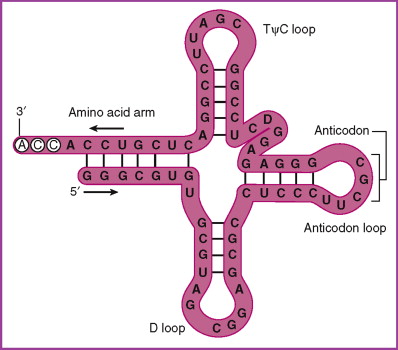


 النبات
النبات
 الحيوان
الحيوان
 الأحياء المجهرية
الأحياء المجهرية
 علم الأمراض
علم الأمراض
 التقانة الإحيائية
التقانة الإحيائية
 التقنية الحيوية المكروبية
التقنية الحيوية المكروبية
 التقنية الحياتية النانوية
التقنية الحياتية النانوية
 علم الأجنة
علم الأجنة
 الأحياء الجزيئي
الأحياء الجزيئي
 علم وظائف الأعضاء
علم وظائف الأعضاء
 الغدد
الغدد
 المضادات الحيوية
المضادات الحيوية|
أقرأ أيضاً
التاريخ: 13-6-2018
التاريخ: 12-3-2018
التاريخ: 29-12-2015
التاريخ: 10-12-2015
|
Transfer RNAs Genes
Genes in the transfer RNAs gene group provide instructions for making molecules called transfer RNAs (tRNAs). Transfer RNAs are a particular type of RNA, which is a chemical cousin of DNA. These molecules help assemble protein building blocks (amino acids) into functioning proteins. Each tRNA attaches to a particular amino acid. During protein assembly, the tRNA recognizes a specific three-letter sequence (a codon) in the genetic blueprint for making proteins and inserts the amino acid into the appropriate location in the growing protein.
There are two classes of tRNA: cytoplasmic and mitochondrial. Cytoplasmic tRNAs are found in the fluid inside cells (the cytoplasm). These tRNAs help produce proteins from genes located in the DNA in the nucleus of the cell (nuclear DNA). Although most DNA is nuclear, cellular structures called mitochondria have a small amount of their own DNA, called mitochondrial DNA. Proteins produced from genes located in mitochondrial DNA are assembled by mitochondrial tRNAs.
Mutations in transfer RNA genes reduce the ability of the tRNA to add amino acids to proteins, slowing protein production. Mutations that affect mitochondrial tRNAs impair the ability of mitochondria to provide energy for cells or to control blood sugar levels. These mutations can cause a variety of signs and symptoms, including muscle weakness, seizures, neurological problems, hearing loss, and diabetes. Mutations in genes that provide instructions for cytoplasmic tRNAs do not appear to cause disease.
Examples of genes in this gene group: MT-TE, MT-TH, MT-TK, MT-TL1, MTTS1,MT-TV
The HUGO Gene Nomenclature Committee (HGNC) provides an index of gene groups (https://www.genenames.org/data/genegroup/#!/group/478) and their member genes.

References
McClain WH. Transfer RNA identity. FASEB J. 1993 Jan;7(1):72-8. Review. PubMed: 8422977 (https://www.ncbi.nlm.nih.gov/pubmed/8422977).
Rich A, RajBhandary UL. Transfer RNA: molecular structure, sequence, and properties. Annu Rev Biochem. 1976;45:805-60. Review. PubMed: 60910 (https://www.ncbi.nlm.nih.gov/pubmed/60910).
Suzuki T, Nagao A, Suzuki T. Human mitochondrial tRNAs: biogenesis, function, structural aspects, and diseases. Annu Rev Genet. 2011;45:299-329. Epub 2011 Sep 6. Review. PubMed: 21910628 (https://www.ncbi.nlm.nih.gov/pubmed/21910628).



|
|
|
|
دخلت غرفة فنسيت ماذا تريد من داخلها.. خبير يفسر الحالة
|
|
|
|
|
|
|
ثورة طبية.. ابتكار أصغر جهاز لتنظيم ضربات القلب في العالم
|
|
|
|
|
|
|
العتبة العباسية المقدسة تستعد لإطلاق الحفل المركزي لتخرج طلبة الجامعات العراقية
|
|
|